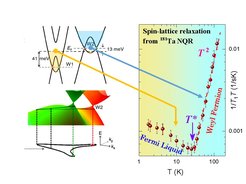Exploring bulk Dirac- and Weyl-fermion magnetism by local probes: Nuclear-Spin and Muon-Spin resonance (NMR & µSR)
Compensated d-electron semimetals (SM) like the monophosphites NbP and TaP, with non centrosymmetric structure and sizable spin orbit interaction (few tens meV) form a new class of material: the Weyl semimetals (WSM) [1,2]. The hallmark of Weyl semimetals is the formation of pairs of Weyl points in reciprocal space and their linear dispersion relation leading to mass less fermions when the Fermi energy crosses exactly the Weyl points. In contrast to the topological insulators where a linear dispersion is found on the surface in WSM this dispersion is found in the bulk. Furthermore due to the spin orbit coupling the Weyl fermions have a chirality on their linear dispersive bands. The density of states (DOS) for Dirac- and Weyl-SMs exhibits an unconventional energy-dependence with N(E) ~ E2 which is in contrast to conventional metals where N(E) ~ E1/2 is valid. As a consequence, Weyl fermions show unconventional electron and heat transport phenomena. Furthermore pronounced quantum oscillations of hole and electron bands could be observed and, due to the moderate spin-orbit interaction, these Landau bands are spin-splitted [3]. Magnetic resonance has (in contrast to neutron scattering) a large potential as a local probe for linear d- electron bands. The NMR shift provides direct information about the s- and d-electron contributions to the density of states DOS at the Fermi level EF, whereas the spin lattice relaxation provides information about the low energy excitations onto s- and d-electrons around EF. Weyl semi-metals (NbP, TaP) as well as Dirac semi metals (Cd3As2 [3], Na3Bi [4] for example) could be tuned towards the Weyl (Dirac) point by doping, pressure, strain or gating. This brings these systems towards the quantum limit. For this case, field-dependent NMR measurements could probe quantum oscillations as well as fluctuations (see for example early work on InSb [5]). Beside quantum oscillations and quantum fluctuations (Weyl- or Dirac- matching) NMR senses tiny field variations (0.1 mT) and therefore is capable to resolve spin-splitted bands and anisotropies due to the spin chirality. Beside local magnetic properties NMR has access to the local “electric” field gradient at the nucleus via the first and second order quadrupole interaction in case of higher nuclear spins (I > ½) like Nb or Ta. Eventually this is a useful tool to probe the Berry flux between the two Weyl points. Transition metal monophosphides like NbP and TaP are very promising candidates and 31P is a superb NMR nucleus (I=1/2) with 100% natural abundance and a very high gyromagnetic ratio. In addition 93Nb (I=9/2) and 181Ta (I = 7/2) are also good NMR nuclei but they have a higher spin where in addition quadrupole effects have to be taken into account. Recently we succeeded in probing Weyl- fermion excitations by pure Ta - Quadrupole resonance (NQR) at zero magnetic field [6,7,8].
We have also published a comparative study on TaAs and TaP [9] and submitted a Nb NMR study on the Weyl semi-metal monopnictide NbP [10]. After the monopnictides, we focused on dipnictides: Our results of Ta NQR on TaSb2 are now published [11] and a manuscript on Te NMR under pressure on the superconductor MoTe2 is under preparation [12]

The solid state NMR group at MPI CPfS provides an excellent NMR set-up with a very wide range of accessible frequencies (1 MHz – 1 GHz) and fields (up to 14 T) and various NMR techniques. In addition the NMR group at TU Dresden around Professor H.H. Klauss can perform solid-state NMR down to the mK regime which leads to an extreme enhancement in resolution. Furthermore the group of H.H. Klauss has a long-standing expertise in µSR measurements. In contrast to NMR µSR probes magnetic fluctuations in the zero field limit with very high sensitivity. The combination of both resonance techniques (NMR and µSR) certainly leads to new insides into the local Dirac – and Weyl-fermion magnetism.
To carry out the above project using microscopic probes, we need to have extremely pure and homogeneous samples. Those have been provided by the outstanding in-house synthesis group (in the chemistry department of Prof. C. Felser). It is also indispensable to have a strong collaboration with theorists. The strong support on the theory of Weyl and Dirac materials has been undertaken with theoretical in-house group as well as the group at the University of Budapest (Prof. B. Dora) and the University of Tokyo (Prof. H. Ogata).
Within the frame of this project, single crystals of the transition metal (Nb, Ta) monopnictides (P, As) have been investigated by solid state NMR, NQR and µSR. Due to the strong magnetic anisotropy, part of the NMR measurements are conducted in a single crystal with the goniometric NMR probe. In addition to the magnetic resonance the samples are characterized by specific heat and magnetic susceptibility (down to 0.35 K in fields up to 14 T). An NMR case study on NbP as well as on TaP single crystals conducted recently at the MPI CPfS provided a very nice set of data and validated the high impact of the NMR method on the Weyl- and Dirac-fermion physics.
References












